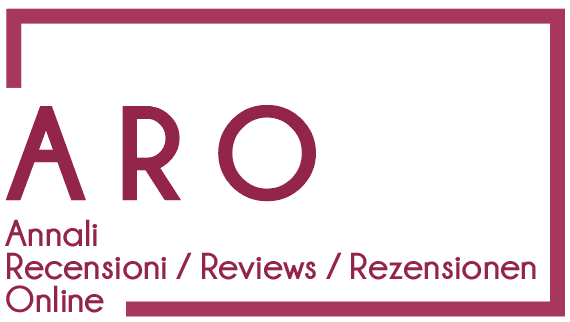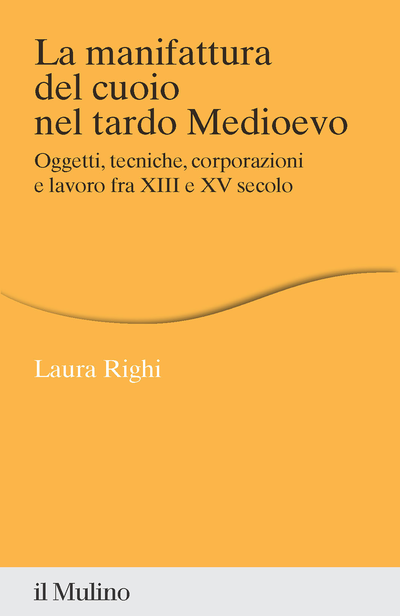


Reviewer Anna Gialdini - Biblioteca FBK, FBK-ISIG
CitationThere is no overstating how widespread and even ubiquitous objects made with animal skins were in the late Middle Ages in Italy. Behind this undeniable statement, however, there lies a complex cosmos of professional practices and identities, public policies touching on aspects as wide ranging as sourcing, labour, and urban planning, and composite self-fashioning strategies on the part of those who purchased and wore the final products. Laura Righi’s book focuses on the specific case study of production and consumption of leather items in Bologna and other cities in northern and central Italy, painting a detailed and insightful overview of processes and ‘know-howʼ as well as practices and regulations pertaining to an active and fundamental industry. Researching such a broad subject (and a versatile material) inevitably requires a degree of selection: hence Righi’s choice to focus on footwear amongst a wide pick of manufactured leather products and on urban spaces as a place of production.
If her analysis of practices and products is exhaustive, Laura Righi truly comes into her own in the chapters dedicated to economic and labour history, where she describes the details of local regulations and day-to-day practices; a truly interdisciplinary analysis, the book delves into environmental history – by looking at how water and skins were sourced for the leather industry, how its waste was managed in urban environments, and how local authorities chased compromises between productivity, decorum, health, and protecting organisations; it also provides in-depth considerations on the social history of leather – through discussions of the often overlapping professional bodies and figures involved and their functioning, the role of guilds, the perception of this line of work in general society, and of footwear ownership (or lack thereof). Sumptuary laws offer a particularly privileged view of the production and consumption of leather objects and more in general the material culture perspective on the leather industry, showing as they do different, gendered and socially-connotated approaches to visual display in public spaces (Righi is particularly well versed on sumptuary laws and it shows).
The focus on certain case studies, both geographical and in terms of products selected for a more in depth analysis, is sensible – Bologna presenting a wide range of primary sources, that Righi skillfully parses into the sections of her book, and shoes being by far the most commonly produced and sold leather objects in late medieval Italy (amongst those who did own and wear shoes, the average consumer could be expected to go through four pairs every year)[1]. Footwear has been at the fore and centre in material culture studies for at least the last 20 years, and for good reason: the high visibility and wide presence of shoes in medieval and early modern societies and their potential for customisation and self-fashioning made them versatile items; as archeological finds, additionally, they are preserved in non-negligible numbers[2].
Righi’s analysis of production processes, of course, applies to more than footwear: some, such as tanning, did not change much over the centuries, while the organisation of labour saw an evolution throughout time. The specificities of this diversified sector are well described: unlike other areas of production, such as textiles, customers could not expect to take semi-finished products home to be completed in a domestic environment, inevitably leading to a high degree of specialisation in the leathermaking sector, and some materials (such as tanning materials) could account for a very high percentage of costs.
In conclusion, this book presents a very strong, interdisciplinary analysis of leather making and working in late medieval Italian urban areas; it will certainly be a staple read for those interested in the topic for a long time to come. The Appendix – providing a comprehensive list of nearly 3,000 individuals matriculated in the relevant Bolognese guilds between 1294 and 1316 – goes to show how important the sector was in the city.
Alongside its rich text, the book could have benefited from a higher number of illustrations: it contains several maps, tables, and graphs that contribute to showing quantitative data from the Bolognese case study; but none of the visual sources that Righi had included in the original manuscript of her PhD thesis, ranging from marketplace scenes to the ubiquitous presence of footwear in late medieval art to museum objects (scenes showing artisans at work are, unsurprisingly, less common), which she rightfully recognises as an important source for her research.
I – and, I am sure, many others – would certainly find it particularly interesting if future research by Laura Righi or others could build on this solid ground to develop into other industries; the interactions between professionals in the leather industry and printers, booksellers, and bookbinders, for instance, are an understudied area that can illuminate a particularly rich supply and demand process, given that parchment, alum-tawed skins, and leather were all widely used in the book industry well into the modern era.
[1] A very recent contribution by Righi goes over footwear reusing and recycling practices in Tuscany in the thirteenth and fourteenth century: L. Righi, Comprare e riparare: prezzo e consumo delle calzature in area toscana (1270-1370 ca.), in E. Tosi Brandi (ed.), Quantum valet. I valori della moda nei secoli XIII-XIV Roma, Viella, 2025, pp. 301-316.
[2] Some examples of fundamental studies on footwear and social and cultural identities in early modern Italy include M. O’Malley, A Pair of Little Gilded Shoes: Commission, Cost, and Meaning in Renaissance Footwear, in «Renaissance Quarterly», 63, 2010, pp. 45-83 and U. Rublack, Matter in the Material Renaissance, in «Past & Present», 219, 2013, pp. 41-85.